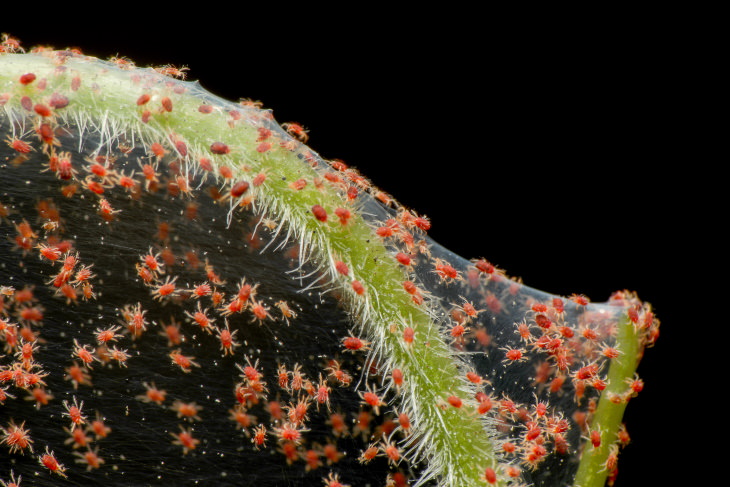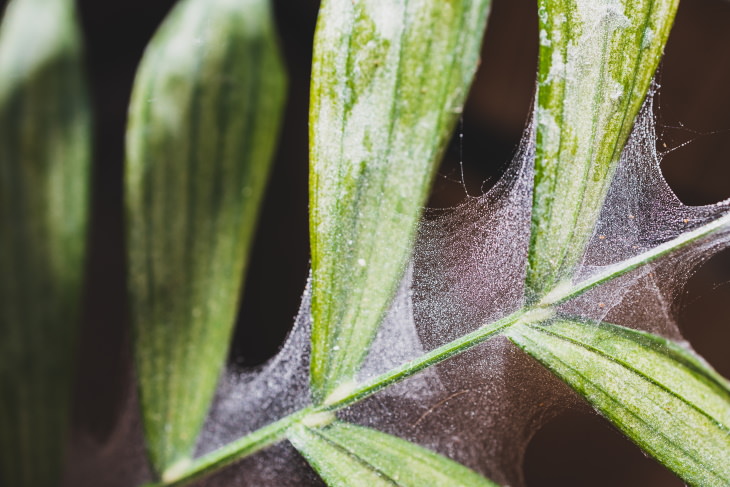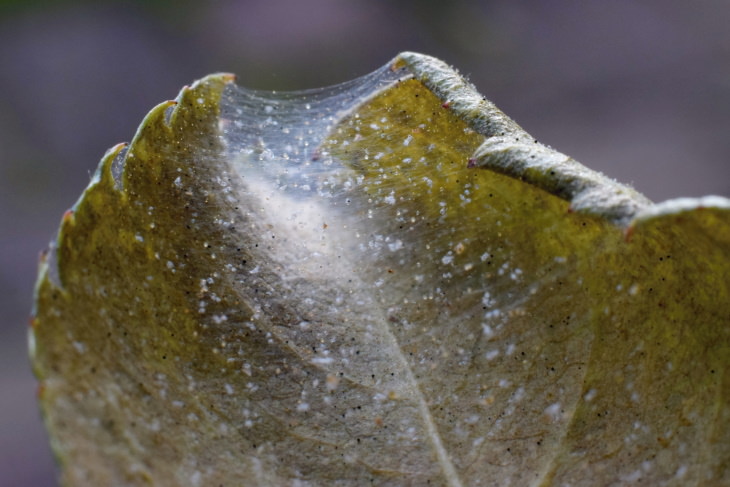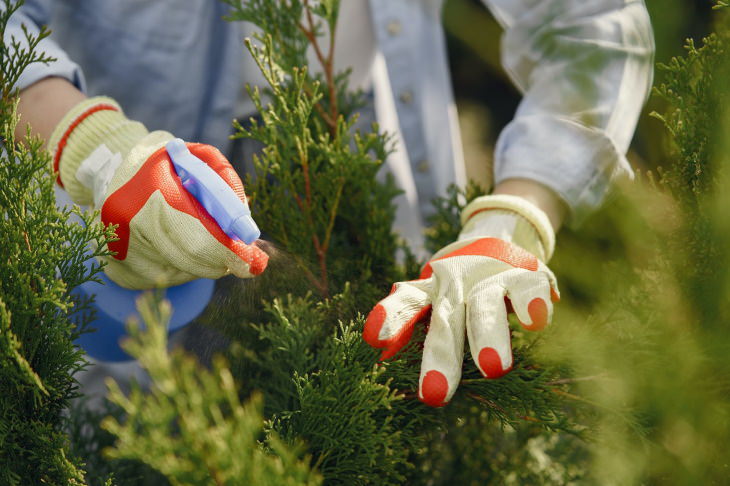
Spider mites are insidious plant pests. These microscopic arachnids hide under the leaves and suck the moisture out of a plant’s tissues, are they are extremely tricky to spot until the infestation becomes rather advanced. And under the right conditions, a spider mite colony can double in less than a week, leaving the plant owners mystified as to why their beloved houseplant or garden plant is fading away in front of their eyes.
Find out how to spot spider mites, protect your plants from these pesky pests, and treat a plant struggling with a spider mite infestation right here in this article.

Spider mites are tiny arachnids related to spiders and ticks. Depending on the species and stage of development, these arachnids can either be translucent, green, reddish-brown, or yellow, but due to their microscopic size, spider mites appear as a white powder that can be easily confused for regular dust.
An advanced infestation is often easier to spot because spider mite colonies cast a spiderweb and congregate in the webbing. When looking for spider mites, examine the underside of the leaf and search for tiny spider webs near the stem and the leaf. Also, take a look at the leaf - you can sometimes see tiny holes on the leaf, and the leaf itself will have a mottled appearance with discolored yellow and brown spots.
Spider mites thrive in a warm and dry environment, so they’re extremely common outdoors and indoors during the summer but can also infect indoor plants during the cold months, right at the beginning of the heating season. For gardeners who live in a hot and arid climate, spider mites are a notorious and frequent issue from July to September.

Even though spider mites can appear on practically every type of plant, certain plant species are even more vulnerable to these pests. Such plants include:
That being said, plants with thick, waxy, or succulent leaves are less likely to sustain lasting damage from spider mites. Jade plants, ZZ plants, snake plants, and rubber trees are all considered almost immune to spider mite infestations. Choosing to grow these plants is a great way to prevent spider mite problems.
In areas where spider mites are a frequent threat, it’s always more beneficial to prevent infestations by creating conditions that are inhospitable for these arachnids. Water is the enemy of the spider mite, so hosing down outdoor plants from time to time goes a long way toward preventing them.
When it comes to indoor plants, increasing the humidity around the plants by either spraying the plants with water or using an air humidifier is one of the best things you can do. In a similar vein, wiping down the leaves of your indoor plants with a damp cloth every few weeks can further reduce the risk of a spider mite problem.
Sometimes, you can bring spider mites with you from the garden center. Since spider mite eggs are so tiny that they’re difficult to spot with a magnifying glass, you can never effectively eliminate this risk when purchasing a plant. Therefore, our last recommendation would be to “quarantine” new plants for 3-4 weeks before you decide to group them with the rest of your plants.

Dealing with a spider mite problem is not very easy, but with persistence and a trained eye, you’ll learn to eradicate these pests within a few weeks. Our first tip towards success is acting as soon as possible. A spider mite’s life cycle can be as short as 5 days, and every female mite lays hundreds of eggs, so treating the infestation in a timely fashion is key. In addition, remember that spider mites can travel from plant to plant, so it’s best to isolate any affected plants whenever possible.
Luckily, when it comes to spider mites, home remedies often pack the most powerful punch. Below we list several effective methods you can try, and many plant owners see the most success in using a few different pest remedies interchangeably. You can mix and match several home remedies and use a different method on a weekly basis for best results.
Note - always treat your plants at the end of the day. This way, you avoid killing beneficial insects in your garden. Some of the methods may also prevent the plant from photosynthesizing for a short time or may burn the plant’s leaves when exposed to bright sunlight - two more reasons to apply insecticide, homemade or not, at dawn.

In a clean sprayer bottle, combine 2-3 drops of dish soap, 1 tablespoon of rubbing alcohol, and lukewarm water. Shake well, and then use this mixture to spray both sides of the leaves and stems of the affected plant. Let the soapy water sit on the plant for 10-15 minutes, and then take a damp cloth and thoroughly wipe down the plant. As the last step, move the plant to a bathtub or sink and rinse it generously with lukewarm water. When working with garden plants, simply hose down the leaves for this last step.
Once you’re done, there should a visible reduction in the white dust on the plant’s leaves. Check the plant again in 5-7 days. You can repeat this method weekly until the issue resolves completely.
Horticultural oil and neem oil are both effective against spider mites. The advantage of neem oil, in particular, is that it also kills spider mite eggs. All you have to do is follow the packaging instructions, spray the plant with the oil, and the spider mites will stick to it and die. Some of these oils come in a concentrate, whereas others are ready to use as is - so make sure to read the label before using.

Spider mites are the vampires of the plant world. And just like these legendary bloodthirsty monsters, spider mites can’t stand garlic. How do you use this kitchen staple against the notorious pest? Just peel and crush 1 full head of garlic, place it in a container, and cover it with 1 gallon of water. Let this mixture sit for 30 minutes, then drain the garlic and spray the liquid directly onto the plant. After about 1-2 hours, we recommend rinsing the plant with plenty of lukewarm water.
A similar brew can also be made with onions. Just chop up 1/3 cup of onions, add it to a stock pot along with 1 gallon of water and simmer for 30-40 minutes. Then remove the pot from the heat and let it cool to room temperature. Use this onion water to spray the plants - no additional diluting is necessary.
Other Spider Mite Insecticides
Apart from home remedies, you can also use store-bought insecticides or even beneficial insects like ladybugs and lacewings to eliminate spider mites. For a full guide on beneficial insects, read this article - Attracting Beneficial Garden Insects.
As for chemical-based pesticides, pyrethroid pesticides, malathion, cyfluthrin, and bifenthrin are all considered effective against spider mites. However, these harsher chemicals are generally reserved for widespread infestations only after other, more natural methods have failed because they can be toxic to beneficial insects in your garden, as well as pets, or even humans. Talk to a professional at your local garden center and follow the usage instructions carefully if you’re considering one of these harsher insecticides.
Happy gardening! Please share this article with fellow gardeners
H/T: The Spruce, Treehouse, Gardening Knowhow